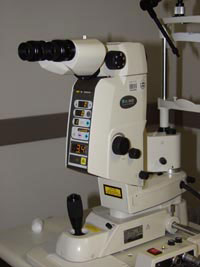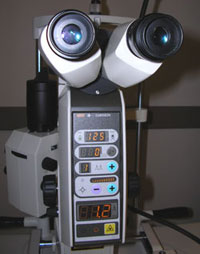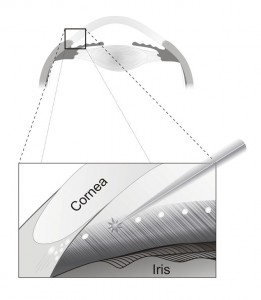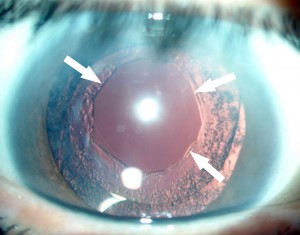(Removing a secondary cataract with a laser, a procedure called capsulotomy)
During cataract surgery, your eye-surgeon will replace the natural lens of the eye with an artificial one which is transparent and will remain that way for ever. The reason for removing the natural lens is connected to its gradual opacification, so that instead of being clear (like water) it slowly becomes cloudy (like milk).
After cataract surgery, it is not possible for the cataract to return, since the original lens is no longer found in the eye. However, there is a condition, known as a ‘secondary cataract’, which is often mistakenly known in lay terms as the return of the cataract. A secondary cataract is not really a new cataract; rather it is the clouding of the posterior (back) capsule which is intentionally left in place at the time of the initial surgery. In one-third to one-fourth of cases this capsule will lose its translucency over time. Luckily for us, there is a simple way to correct the situation, in the form of an elegant and quick clinic procedure utilizes laser energy, which does not necessitate a return visit to the operating room.
This laser treatment is known as ‘capsulotomy’, implying that an opening of the posterior capsule is created by means of laser light. This treatment is considered relatively gentle, and is associated with a much lower risk than that of the initial cataract surgery. However, it is a procedure which requires expertise, precision, and experience in order to achieve an optimal outcome.
During the treatment, the doctor will anesthetize the eye using drops, will dilate the pupil, and will then sit the patient in front of a specialized laser designed for this purpose. The treatment itself is painless, and in fact, is often not even felt. A lens is approximated to the eye that will undergo treatment. This ensures that the eye and eyelid will not move significantly during the laser treatment. Then, the doctor will fire microscopic laser shots, directed at the cloudy posterior capsule. This is done with the objective of opening a small aperture (several millimeters in size) which will allow for an improvement in visual acuity of the eye. Capsulotomy is performed in our clinic at a relatively high frequency. In the great majority of cases there is an immediate improvement in visual acuity. In fact, as early as an hour after the procedure a person can often feel that the vision in the treated eye is clearer and sharper. Additionally, there is an increase in the amount of light that penetrates the eye (a lighter, clearer, and sharper picture).
In conclusion, a capsulotomy is performed in some eyes that have undergone cataract surgery, when the posterior capsule becomes cloudy. This generally occurs of its own accord and is not associated with the quality of the initial surgery or its success. As soon as the ophthalmologist identifies the problem, and if its severity justifies laser treatment, the patient will be referred for this procedure. If the treatment was successful, the person’s visual acuity will, in all likelihood, improve. It is interesting to note that this cloudiness is a result of the proliferation of lens cells which sense that the lens no longer exists, and try (unsuccessfully, of course) to replace what is lacking. This phenomenon is much more common in young eyes (such as those of children) in which the lens cells are young and healthy, and wish to proliferate to compensate for lost lens tissue (the aim of cataract surgery is to have the lens removed).
If your eye, or the eye of a family member, is found to have a secondary cataract (which is a misnomer implying that cloudiness of the posterior capsule developed), I advise you to consider having this laser procedure performed. The treatment has high success rates, and is short, simple, and safe.




